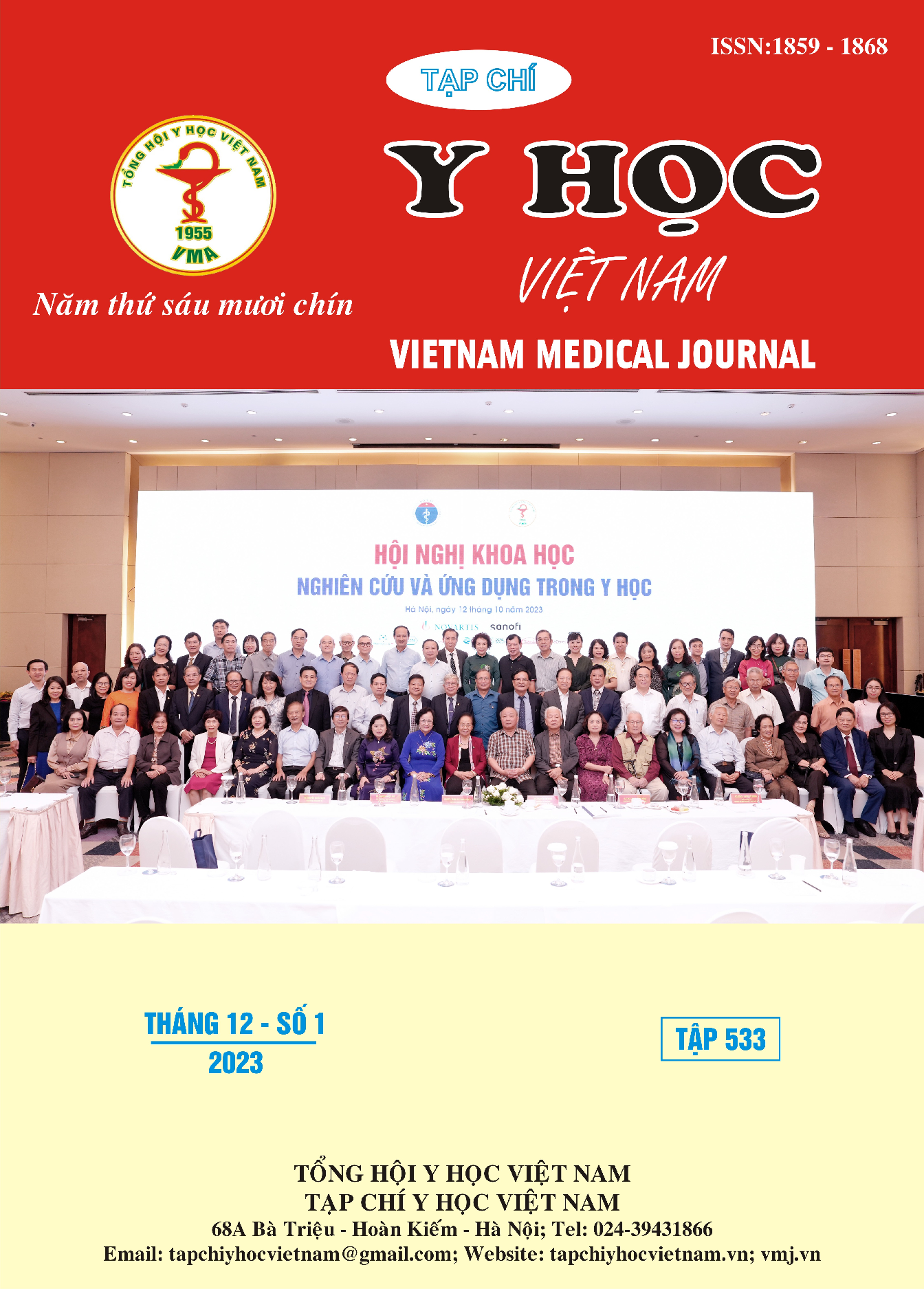SOME FACTORS AFFECTING THE STONE RECURRENCE RATE IN PATIENTS TREADED INTRAHEPATIC AND EXTRAHEPATIC LITHIASIS BY PERCUTAEOUS TRANSHEPATIC CHOLANGIOSCOPY LITHOTRIPSY
Main Article Content
Abstract
Purpose: Analysis of some factors affecting the stone recurrence rate in patients with intrahepatic and extrahepatic stones have undergone percutaneous transhepatic transhepatic cholangioscopy lithotripsy. Subjects and methods: This study is a retrospective review of 59 patients had intrahepatic and common bile duct stones and treated using percutaneous transhepatic cholangioscopy lithotripsy from January 2020 to August 2022 at Radiology Center – Hanoi Medical University Hospital. Results:. The study was conducted on 65 patients to analyze some factors affecting the results (stone recurrence rate) of intrahepatic and extrahepatic bile duct lithotripsy after percutaneous laser lithotripsy in long-term, with a median follow-up period of 27 months (IQR 3-37), showing that the rate of Overall stone recurrence was 43 patients (66.2%). The risk factor for a higher rate of stone recurrence is biliary stricture (OR, 5.4; 95% CI, 1.7-17.3; p=0.03); cholangitis on imaging (OR, 4.7; 95% CI, 1.2-18.7, p= 0.033); liver damage (OR, 5.0; 95% CI, 1.5-16.4; p=0.006); stone distribution in the liver (OR, 9.5; 95% CI 1.7-51.3; p=0.005) and stone retention (p=0.00). Conclusion: factors such as biliary stenosis, cholangitis, liver damage, distribution of stones, and stone retention can contribute to increasing the rate of stone recurrence after treatment with TSDMQDL. Therefore, assessing the above factors before percutaneous transhepatic transhepatic cholangioscopy lithotripsy is necessary to predict long-term effectiveness and devise a treatment plan to reduce the recurrence rate.
Article Details
Keywords
percutaneous transhepatic cholangioscopy lithotripsy, cholelithiasis, recurrence rate, stone recurrence factor, long term.
References
2. Tyson GL, El-Serag HB. Risk factors for cholangiocarcinoma. Hepatol Baltim Md. 2011; 54(1):173-184. doi:10.1002/hep.24351
3. Ong GB. A study of recurrent pyogenic cholangitis. Arch Surg Chic Ill 1960. 1962;84:199-225. doi:10.1001/archsurg.1962.01300200047004
4. Khôi, L.N. Đánh giá kết quả điều trị sỏi trong gan bằng phẫu thuật nối mật - da với đoạn ruột biệt lập và nối mật - ruột - da. Gan -- Phẫu thuật. 2015:138.
5. Cappelli A, Mosconi C, Cucchetti A, et al. Outcomes following percutaneous treatment of biliary stones. HPB. 2019;21(8):1057-1063. doi:10.1016/j.hpb.2018.12.007
6. Hong KS, Noh KT, Min SK, Lee HK. Selection of surgical treatment types for intrahepatic duct stones. Korean J Hepato-Biliary-Pancreat Surg. 2011;15(3): 139-145. doi: 10.14701/ kjhbps. 2011.15.3.139
7. Lujian P, Xianneng C, Lei Z. Risk factors of stone recurrence after endoscopic retrograde cholangiopancreatography for common bile duct stones. Medicine (Baltimore). 2020;99(27): e20412. doi:10.1097/MD.0000000000020412
8. Nakayama F, Soloway RD, Nakama T, et al. Hepatolithiasis in East Asia. Retrospective study. Dig Dis Sci. 1986;31(1):21-26. doi: 10.1007/ BF01347905
9. Đình Khánh Đ. Đánh giá kết quả tán sỏi đường mật trong và ngoài gan qua da bằng Laser. Tiêu Hóa. Published online 2021.
10. Lee SK, Seo DW, Myung SJ, et al. Percutaneous transhepatic cholangioscopic treatment for hepatolithiasis: an evaluation of long-term results and risk factors for recurrence. Gastrointest Endosc. 2001;53(3):318-323. doi: 10.1016/s0016-5107(01)70405-1


